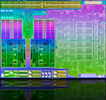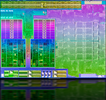AMD A8-4557M vs AMD A10-4657M
AMD A8-4557M
► remove from comparison
The AMD A8-4557M is a mobile quad-core processor based on the Trinity architecture and the direct successor to the Llano A-series of APUs (Accelerated Processing Unit). The processing unit is manufactured in 32nm SOI and integrates a 1.9 GHz CPU (up to 2.8 GHz w/ Turbo Core) with a relatively fast Radeon HD 7640G GPU alongside a dual-channel memory controller, video decoders and a northbridge. The A8-4557M is the BGA version of the A8-4500M.
The CPU cores are based on a reworked Bulldozer architecture called Piledriver. Although marketed as a quad-core processor, the A8-4557M includes only two modules with four integer-cores and two floating-point cores total. As a result, the CPU is not a true quad-core processor.
When compared to previous Bulldozer cores, AMD has managed to improve upon the IPC (instructions per clock) performance of Trinity cores while allowing for higher clock frequencies. However, when compared to its Llano predecessor, the multithreaded performance of Trinity has only been slightly improved. The enhanced Turbo Core 3.0 feature performs well in speeding up single-threaded applications, although it still underperforms compared to Intel’s Turbo Boost equivalent. Regardless, AMD has managed to include other features as well, such as the AVX extension (including FMA) and support for AES encryption.
In terms of raw general performance, the A8-4557M performs similarly to the Llano-based A8-3500M. Single-threaded workloads can especially benefit from the new architecture and the updated Turbo Core functionality. If compared to Intel's Core-i3 series, the A8-4557M offers less performance in most cases. Nonetheless, CPU performance from the AMD processor should be sufficient for all daily workloads like Office, Internet browsing and even light video editing or gaming.
The integrated DirectX 11-compatible Radeon HD 7640G offers only 256 shader cores of the Trinity chip (7660G: 384) and, thanks to Turbo Core, will operate anywhere between 497 to 686 MHz depending on the current application demand. On average, the performance of the HD 7640G GPU is comparable to a dedicated Radeon HD 7610M and is faster than the HD Graphics 4000 as found on Intel’s Ivy Bridge platform.
The power consumption of the A8-4557M APU is rated at 35 Watt TDP and is therefore comparable to mid-range dual-core Ivy Bridge processors. Consequently, the A8-4557M is best suited for 14-inch notebooks or larger.
AMD A10-4657M
► remove from comparison
The AMD A10-4657M is a mobile quad-core processor based on the Trinity architecture. The processing unit is manufactured in 32nm SOI and integrates a 2.3 GHz CPU (up to 3.2 GHz w/ Turbo Core) with a relatively fast Radeon HD 7660G GPU alongside a dual-channel memory controller, video encoders and a northbridge. The A10-4657M is the BGA version of the A10-4600M.
The CPU cores are based on a reworked Bulldozer architecture called Piledriver. Although marketed as a quad-core processor, the A10-4657M includes only two modules with four integer-cores and two floating-point cores total. As a result, the CPU is not a true quad-core processor.
When compared to previous Bulldozer cores, AMD has managed to improve upon the IPC (instructions per clock) performance of Trinity cores while allowing for higher clock frequencies. However, when compared to its Llano predecessor, the multithreaded performance of Trinity has only been slightly improved. The enhanced Turbo Core 3.0 feature performs well in speeding up single-threaded performance, although it is still underperforms compared to Intel’s Turbo Boost equivalent. Regardless, AMD has managed to include other features as well, such as the AVX extension (including FMA) and support for AES encryption.
In terms of raw general performance, the A10-4657M can perform anywhere from 0 to 25% faster than the Llano-based A8-3520M. Single-threaded workloads can especially benefit from the new architecture and the updated Turbo Core functionality. If compared to Intel, a Sandy Bridge Core i3-2310M is roughly similar to the A10-4657M, but results can still differ greatly from benchmark to benchmark. Nonetheless, CPU performance from the AMD processor should be sufficient for all daily workloads like Office, Internet browsing and even light video editing or gaming.
The integrated DirectX 11-compatible Radeon HD 7660G offers all 384 shader cores of the Trinity chip and, thanks to Turbo Core, will operate anywhere between 497 to 686 MHz depending on the current application demand. On average, the performance of the HD 7660G GPU is comparable to a dedicated Radeon HD 6650M and is noticeably faster than the HD Graphics 4000 as found on Intel’s Ivy Bridge platform.
The power consumption of the A10-4657M APU is rated at 35 Watt TDP and is therefore comparable to mid-range dual-core Ivy Bridge processors. Consequently, the A10-4657M is best suited for 14-inch notebooks or larger.
| Model | AMD A8-4557M | AMD A10-4657M | ||||||||||||||||||||||||||||||||||||||||||||||||||||||||||||||||||||||||||||||||
| Series | AMD A-Series | AMD A-Series | ||||||||||||||||||||||||||||||||||||||||||||||||||||||||||||||||||||||||||||||||
| Codename | Trinity | Trinity | ||||||||||||||||||||||||||||||||||||||||||||||||||||||||||||||||||||||||||||||||
| Series: A-Series Trinity |
|
| ||||||||||||||||||||||||||||||||||||||||||||||||||||||||||||||||||||||||||||||||
| Clock | 1900 - 2800 MHz | 2300 - 3200 MHz | ||||||||||||||||||||||||||||||||||||||||||||||||||||||||||||||||||||||||||||||||
| L2 Cache | 4 MB | 4 MB | ||||||||||||||||||||||||||||||||||||||||||||||||||||||||||||||||||||||||||||||||
| Cores / Threads | 4 / 4 | 4 / 4 | ||||||||||||||||||||||||||||||||||||||||||||||||||||||||||||||||||||||||||||||||
| TDP | 35 Watt | 35 Watt | ||||||||||||||||||||||||||||||||||||||||||||||||||||||||||||||||||||||||||||||||
| Transistors | 1303 Million | 1303 Million | ||||||||||||||||||||||||||||||||||||||||||||||||||||||||||||||||||||||||||||||||
| Technology | 32 nm | 32 nm | ||||||||||||||||||||||||||||||||||||||||||||||||||||||||||||||||||||||||||||||||
| Die Size | 246 mm2 | 246 mm2 | ||||||||||||||||||||||||||||||||||||||||||||||||||||||||||||||||||||||||||||||||
| Socket | BGA | BGA | ||||||||||||||||||||||||||||||||||||||||||||||||||||||||||||||||||||||||||||||||
| Features | SSE (1, 2, 3, 3S, 4.1, 4.2, 4A), x86-64, AES, AVX, FMA | SSE (1, 2, 3, 3S, 4.1, 4.2, 4A), x86-64, AES, AVX, FMA | ||||||||||||||||||||||||||||||||||||||||||||||||||||||||||||||||||||||||||||||||
| iGPU | AMD Radeon HD 7640G (497 - 655 MHz) | AMD Radeon HD 7660G (497 - 686 MHz) | ||||||||||||||||||||||||||||||||||||||||||||||||||||||||||||||||||||||||||||||||
| Architecture | x86 | x86 | ||||||||||||||||||||||||||||||||||||||||||||||||||||||||||||||||||||||||||||||||
| Announced |
Benchmarks
* Smaller numbers mean a higher performance
1 This benchmark is not used for the average calculation


 Deutsch
Deutsch English
English Español
Español Français
Français Italiano
Italiano Nederlands
Nederlands Polski
Polski Português
Português Русский
Русский Türkçe
Türkçe Svenska
Svenska Chinese
Chinese Magyar
Magyar